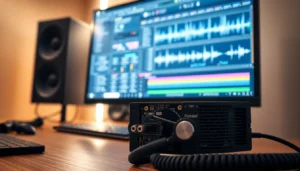In a world where everyone’s a podcaster, musician, or YouTube sensation, having the right microphone can make or break a career. Professional microphones aren’t just fancy gadgets; they’re the unsung heroes that capture every nuance of sound. Imagine your voice sounding as smooth as butter while your audience hangs on every word.
Table of Contents
ToggleOverview Of Professional Microphones
Professional microphones play a crucial role in audio production. These devices come in various types, each designed for specific applications. Dynamic microphones excel in live sound settings. They can handle high sound pressure levels and provide durability.
Condenser microphones are widely used in studio recordings. They capture sound with great clarity and detail, making them suitable for vocals and instruments. Ribbon microphones deliver a warm tone and are often favored for recording acoustic instruments.
Different pickup patterns enhance microphone versatility. Cardioid microphones focus on sound from the front, rejecting noise from the sides and back. Omnidirectional microphones capture sound in all directions, allowing for a more natural sound presence.
Factors like frequency response and sensitivity impact microphone performance. Frequency response defines the range of sounds a microphone can capture. Sensitivity measures how well a microphone converts sound waves into electrical signals.
Budget options exist for those starting their audio journey. Affordable models provide good quality for beginners, while high-end microphones offer superior sound performance for professionals. Popular brands, such as Shure, Audio-Technica, and Neumann, produce reliable models used across various industries.
Selecting the right professional microphone depends on specific needs and usage scenarios. Sound clarity, durability, and budget considerations guide the choice, ensuring optimal audio quality for every project.
Types Of Professional Microphones

Understanding the different types of professional microphones helps in selecting the right one for specific audio needs. Various types cater to different environments and recording techniques.
Dynamic Microphones
Dynamic microphones excel in live sound settings. They’re durable and handle high sound pressure levels well, making them suitable for loud instruments or vocals. Many performers prefer dynamic microphones for their reliability on stage. These microphones use a diaphragm attached to a coil, which generates an electrical current when sound waves hit it. Shure SM58 and SM57 are popular examples known for their versatility and robustness.
Condenser Microphones
Condenser microphones are favored in studio recordings due to their sensitivity and wide frequency response. They capture audio details and subtle nuances effectively, making them ideal for vocals and acoustic instruments. Inside, a diaphragm sits in front of a backplate, creating a capacitor that responds to sound waves. Common models include the Audio-Technica AT2020 and Neumann U87, popular among audio professionals for their clarity and richness in sound.
Ribbon Microphones
Ribbon microphones are recognized for their warm tone and smooth frequency response. Often chosen for acoustic recordings, they capture natural sound characteristics effectively. A thin metal ribbon hangs between magnets, producing sound when struck by sound waves. While they require careful handling due to their delicate construction, models like the Royer R-121 and AEA R84 are celebrated for their exceptional tonal quality and musicality.
Key Features To Consider
Selecting a professional microphone requires attention to specific features that enhance audio quality. Understanding these characteristics ensures the right choice for various recording needs.
Frequency Response
Frequency response refers to a microphone’s ability to reproduce different audio frequencies. A wide frequency range captures nuances accurately, impacting sound clarity. For vocal recordings, a range of 20 Hz to 20 kHz works best, as it encompasses the full spectrum of human hearing. Some models emphasize high frequencies, creating a brighter sound, while others focus on mid-range frequencies for richer audio. Evaluating frequency response charts reveals which microphones suit particular applications, making it easier to find the ideal match.
Sensitivity
Sensitivity indicates how effectively a microphone converts sound waves into electrical signals. Measured in millivolts per Pascal, higher sensitivity values deliver stronger output levels with lower sound pressure. This quality is crucial for quiet sources, such as soft-spoken dialogue or acoustic instruments. A microphone with lower sensitivity may require increased gain to capture sound clearly, potentially introducing noise. Those needing to record subtle audio details should prioritize microphones with high sensitivity ratings, ensuring better performance in various recording environments.
Polar Patterns
Polar patterns dictate how microphones pick up sound from different directions. Common patterns include cardioid, omnidirectional, and bidirectional. Cardioid microphones capture sound primarily from the front, effectively isolating the source while minimizing background noise, making it suitable for live performances. In contrast, omnidirectional microphones pick up sound evenly in all directions, capturing ambient sound effectively, perfect for group recordings. Bidirectional models capture sound from the front and back, ideal for interviews or duets. Selecting the appropriate polar pattern improves versatility and audio quality for specific recording scenarios.
Top Professional Microphone Brands
Numerous brands dominate the professional microphone market. Each one brings quality and reliability to the table.
Shure
Shure stands out for its legendary microphones, trusted by professionals worldwide. The Shure SM58 is renowned for live performance, delivering exceptional vocal clarity and durability. With its cardioid pickup pattern, unwanted noise rejection enhances performance integrity. In studio settings, the Shure SM57 captures instruments effectively, showcasing its versatility. These models consistently fulfill high standards, making Shure a top choice for various applications.
Audio-Technica
Audio-Technica offers a range of high-quality microphones favored by musicians and creators. Their AT2020 model excels in studio recordings, capturing fine details in vocal performances. This condenser microphone features a wide frequency response, ideal for accurate sound reproduction. The flagship AT4053b provides even greater precision, making it suitable for professional applications. With reliable products, Audio-Technica remains a staple in audio production.
Rode
Rode microphones gain recognition for superior sound quality and innovative design. The NT1 is revered for its ultra-low self-noise and true-to-life sound reproduction, ideal for studio work. Likewise, the Rode NTG4+ is popular in film production, known for its directional pickup pattern that minimizes background noise. Rode’s commitment to quality ensures their microphones meet the demands of both amateurs and professionals alike. Their diverse lineup continues to impress audio enthusiasts everywhere.
Choosing the right professional microphone is a vital step for anyone serious about audio production. With various types available each suited for specific applications it’s essential to consider factors like frequency response sensitivity and polar patterns. These elements play a significant role in achieving optimal sound quality whether for podcasts music or other creative projects.
Investing in a quality microphone from reputable brands like Shure Audio-Technica or Rode can greatly enhance the listening experience. Whether a beginner or a seasoned professional understanding individual needs and usage scenarios will lead to a more informed choice. This ensures that every recording not only meets but exceeds expectations.



